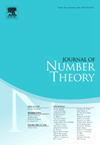椭圆曲线高阶ζ的杂散和Sato-Tate猜想
IF 0.7
3区 数学
Q3 MATHEMATICS
引用次数: 0
摘要
对于有理上的椭圆曲线,有一个著名的Sato-Tate猜想和一种新的计算引导杂音现象,其中使用了阿贝尔Artin - zeta函数。本文证明了对于有理数上椭圆曲线的p约简的非阿贝尔高秩zeta函数,杂散和Sato-Tate猜想同样成立。我们通过仔细检验椭圆曲线E/Fp的阶1 a-不变式aE/Fp=1+p - NE/Fp的阶n类似式aE/Fp,n(n≥1)的渐近行为来建立我们的结果。这种渐近结果是基于所谓的αE/Fq,n-和βE/Fq,n阶E/Fq的不变量的“计数奇迹”,以及βE/Fq,n-不变量的显著递归关系,两者都是由Weng-Zagier在[22]中建立的。本文章由计算机程序翻译,如有差异,请以英文原文为准。
Murmurations and Sato–Tate conjectures for high rank zetas of elliptic curves
For elliptic curves over rationals, there are a well-known conjecture of Sato–Tate and a new computational guided murmuration phenomenon, for which the abelian Artin zeta functions are used. In this paper, we show that both the murmurations and the Sato–Tate conjecture stand equally well for non-abelian high rank zeta functions of the p-reductions of elliptic curves over rationals. We establish our results by carefully examining asymptotic behaviors of the p-reduction invariants , the rank n analogous of the rank one a-invariant of elliptic curve . Such asymptotic results are based on a ‘counting miracle’ of the so-called - and -invariants of in rank n, and a remarkable recursive relation on the -invariants, both established by Weng–Zagier in [22].
求助全文
通过发布文献求助,成功后即可免费获取论文全文。
去求助
来源期刊

Journal of Number Theory
数学-数学
CiteScore
1.30
自引率
14.30%
发文量
122
审稿时长
16 weeks
期刊介绍:
The Journal of Number Theory (JNT) features selected research articles that represent the broad spectrum of interest in contemporary number theory and allied areas. A valuable resource for mathematicians, the journal provides an international forum for the publication of original research in this field.
The Journal of Number Theory is encouraging submissions of quality, long articles where most or all of the technical details are included. The journal now considers and welcomes also papers in Computational Number Theory.
Starting in May 2019, JNT will have a new format with 3 sections:
JNT Prime targets (possibly very long with complete proofs) high impact papers. Articles published in this section will be granted 1 year promotional open access.
JNT General Section is for shorter papers. We particularly encourage submission from junior researchers. Every attempt will be made to expedite the review process for such submissions.
Computational JNT . This section aims to provide a forum to disseminate contributions which make significant use of computer calculations to derive novel number theoretic results. There will be an online repository where supplementary codes and data can be stored.
 求助内容:
求助内容: 应助结果提醒方式:
应助结果提醒方式:


